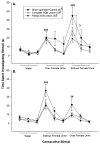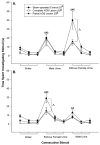Effect of bilateral accessory olfactory bulb lesions on volatile urinary odor discrimination and investigation as well as mating behavior in male mice
- PMID: 17991495
- PMCID: PMC2274908
- DOI: 10.1016/j.physbeh.2007.10.005
Effect of bilateral accessory olfactory bulb lesions on volatile urinary odor discrimination and investigation as well as mating behavior in male mice
Abstract
Previous research raises the possibility that urinary volatiles from estrous female mice activate mitral cells in the accessory olfactory bulb (AOB) of male mice following detection via the main olfactory epithelium as opposed to the vomeronasal organ. We asked whether bilateral lesions of the AOB would disrupt the ability of male mice to discriminate between urinary volatiles from mice of different sexes or endocrine states, or affect their interest in investigating these odors when they were presented sequentially in home-cage habituation/dishabituation tests. Males with either partial or complete bilateral lesions of the AOB resembled sham-operated control males in their ability to discriminate between ovariectomized and estrous female urinary volatiles as well as between male and estrous female urinary volatiles. However, males with either complete or partial AOB lesions spent significantly less time than sham-operated control males investigating urinary volatiles from estrous females, especially during tests when the alternative stimulus presented was male urine. Placement of AOB lesions failed to disrupt males' mating performance. Our results suggest that the incentive value of opposite-sex (female) volatile urinary odors which are initially detected by the main olfactory system is enhanced when they are further processed by the male's AOB.
Figures



Similar articles
-
Optogenetic Activation of Accessory Olfactory Bulb Input to the Forebrain Differentially Modulates Investigation of Opposite versus Same-Sex Urinary Chemosignals and Stimulates Mating in Male Mice.eNeuro. 2017 Mar 23;4(2):ENEURO.0010-17.2017. doi: 10.1523/ENEURO.0010-17.2017. eCollection 2017 Mar-Apr. eNeuro. 2017. PMID: 28374006 Free PMC article.
-
Sexually dimorphic activation of the accessory, but not the main, olfactory bulb in mice by urinary volatiles.Eur J Neurosci. 2007 Jul;26(2):463-75. doi: 10.1111/j.1460-9568.2007.05651.x. Epub 2007 Jul 10. Eur J Neurosci. 2007. PMID: 17623023 Free PMC article.
-
Olfactory sex discrimination persists, whereas the preference for urinary odorants from estrous females disappears in male mice after vomeronasal organ removal.J Neurosci. 2004 Oct 20;24(42):9451-7. doi: 10.1523/JNEUROSCI.2376-04.2004. J Neurosci. 2004. PMID: 15496681 Free PMC article.
-
Neural mechanisms of individual and sexual recognition in Syrian hamsters (Mesocricetus auratus).Behav Brain Res. 2009 Jun 25;200(2):260-7. doi: 10.1016/j.bbr.2008.10.027. Epub 2008 Oct 30. Behav Brain Res. 2009. PMID: 19014975 Free PMC article. Review.
-
Odor-guided behavior in mammals.Experientia. 1986 Mar 15;42(3):257-71. doi: 10.1007/BF01942506. Experientia. 1986. PMID: 3514263 Review.
Cited by
-
Optogenetic Activation of Accessory Olfactory Bulb Input to the Forebrain Differentially Modulates Investigation of Opposite versus Same-Sex Urinary Chemosignals and Stimulates Mating in Male Mice.eNeuro. 2017 Mar 23;4(2):ENEURO.0010-17.2017. doi: 10.1523/ENEURO.0010-17.2017. eCollection 2017 Mar-Apr. eNeuro. 2017. PMID: 28374006 Free PMC article.
-
A centrifugal pathway to the mouse accessory olfactory bulb from the medial amygdala conveys gender-specific volatile pheromonal signals.Eur J Neurosci. 2009 Jan;29(2):368-76. doi: 10.1111/j.1460-9568.2008.06564.x. Epub 2008 Dec 11. Eur J Neurosci. 2009. PMID: 19077123 Free PMC article.
-
Social deficits, stereotypy and early emergence of repetitive behavior in the C58/J inbred mouse strain.Behav Brain Res. 2010 Mar 17;208(1):178-88. doi: 10.1016/j.bbr.2009.11.031. Epub 2009 Nov 24. Behav Brain Res. 2010. PMID: 19941908 Free PMC article.
-
Either main or accessory olfactory system signaling can mediate the rewarding effects of estrous female chemosignals in sexually naive male mice.Behav Neurosci. 2013 Oct;127(5):755-62. doi: 10.1037/a0033945. Epub 2013 Aug 26. Behav Neurosci. 2013. PMID: 23978150 Free PMC article.
-
Trpc2-deficient lactating mice exhibit altered brain and behavioral responses to bedding stimuli.Behav Brain Res. 2011 Mar 1;217(2):347-53. doi: 10.1016/j.bbr.2010.11.002. Epub 2010 Nov 9. Behav Brain Res. 2011. PMID: 21070815 Free PMC article.
References
-
- Barber PC. Adjacent laminar terminations of two centrifugal afferent pathways to the accessory olfactory bulb in the mouse. Brain Res. 1982;245:215–21. - PubMed
-
- Baum MJ, Keverne EB. Sex difference in attraction thresholds for volatile odors from male and estrous female mouse urine. Horm Behav. 2002;41:213–9. - PubMed
-
- Boehm U, Zou Z, Buck LB. Feedback loops link odor and pheromone signaling with reproduction. Cell. 2005;123:683–95. - PubMed
-
- Brown RE. Mammalian social odors. Adv Stud Behav. 1979;10:107–61.
-
- Davis BJ, Macrides F, Youngs WM, Schneider SP, Rosene DL. Efferents and centrifugal afferents of the main and accessory olfactory bulbs in the hamster. Brain Res Bull. 1978;3:59–72. - PubMed
Publication types
MeSH terms
Grants and funding
LinkOut - more resources
Full Text Sources

